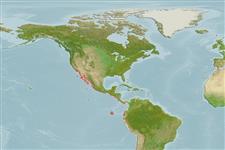Common names from other countries
Teleostei (teleosts) >
Eupercaria/misc (Various families in series Eupercaria) >
Sciaenidae (Drums or croakers)
Etymology: Menticirrhus: Latin, mentum = beard, chin + Latin, cirrus = curly.
More on author: Girard.
Environment: milieu / climate zone / depth range / distribution range
Ecology
Marine; demersal; depth range ? - 14 m (Ref. 9118). Subtropical; 37°N - 21°S, 123°W - 68°W
Eastern Pacific: California, USA to Peru.
Size / Weight / Age
Maturity: Lm ? range ? - ? cm
Max length : 71.0 cm TL male/unsexed; (Ref. 2850); max. published weight: 3.9 kg (Ref. 2850); max. reported age: 8 years (Ref. 56049)
Occur along sandy shores and in bays, usually in sandy surfs of exposed outer coast. Usually found in small groups; larger fish are more solitary. Feed on sand crabs, other small crustaceans, and worms (Ref. 9118). Spawning begins in July (Ref. 9118). Pelagic spawners (Ref. 56049). Cannot produce croaking sounds due to lack of air bladder. Considered a good food fish and is common in markets (Ref. 9118).
Life cycle and mating behavior
Maturities | Reproduction | Spawnings | Egg(s) | Fecundities | Larvae
Pelagic spawner (Ref. 56049).
Eschmeyer, W.N., E.S. Herald and H. Hammann, 1983. A field guide to Pacific coast fishes of North America. Boston (MA, USA): Houghton Mifflin Company. xii+336 p. (Ref. 2850)
IUCN Red List Status (Ref. 130435)
CITES (Ref. 128078)
Not Evaluated
Threat to humans
Harmless
Human uses
Fisheries: commercial; gamefish: yes
Tools
Special reports
Download XML
Internet sources
Estimates based on models
Preferred temperature (Ref.
115969): 17.8 - 28.9, mean 23.6 (based on 262 cells).
Phylogenetic diversity index (Ref.
82804): PD
50 = 0.5020 [Uniqueness, from 0.5 = low to 2.0 = high].
Bayesian length-weight: a=0.00933 (0.00531 - 0.01641), b=3.03 (2.88 - 3.18), in cm Total Length, based on LWR estimates for this species & (Sub)family-body (Ref.
93245).
Trophic level (Ref.
69278): 3.3 ±0.50 se; based on food items.
Resilience (Ref.
120179): Medium, minimum population doubling time 1.4 - 4.4 years (tm=2.5; tmax=8).
Fishing Vulnerability (Ref.
59153): Low to moderate vulnerability (34 of 100).
